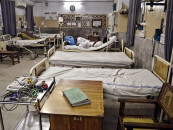ECP bending rules: report
DRI asks commission to share details on reasons for variation

PHOTO: ECP.GOV.PK
A Democracy Reporting International (DRI) study suggests that ECP should release additional data and information about constituencies, including maps, and provide data and information in a format which stakeholders can easily understand and analyse.
The report by DRI Country Representative Hassan Nasir Mirbahar and Senior Programme Officer and Governance and Innovation Expert Ray Serrato said ECP has recently re-drawn electoral constituencies in a way that puts more emphasis on respecting administrative borders than on an equal vote for each citizen. The law is not clear on this point and the ECP has the discretion to prioritise certain criteria. However, the equality of the vote is an essential principle of democratic elections.
Bending rules: Political deputations rankle FIA
It said the recently passed Election Act 2017, among other changes, limits the variation in constituency sizes to a maximum of 10%, in line with international good practice.
History
Pakistan’s history is marked by an inequality of voting among its citizens.
Such inequality of the vote was also observed during 2013 general elections. One constituency, Haripur (NA-19), had over 500% more registered voters than FATA’s Tribal Areas VI (NA-41), with the former tallying 531,685 voters and the latter just 92,719 voters.
The DRI report suggested that this substantial variation in voters distorts the equality of vote, such that the vote of each Pakistani does not count equally; in this extreme example, it means that a voter in Haripur had 500% more power than a voter in the tribal areas. Such large deviations do not provide an equal playing field to candidates in these constituencies.
To address these problems, parliament passed the Election Act 2017. However, the Act required officially published census data to carry out fresh delimitation. The final census results have not been officially published, so the political parties passed a Constitutional Amendment in December 2017 enabling ECP to use provisional census data. ECP has also tried to regulate the conduct of delimitation for the first time.
ECP notifies revised seat allocations for general elections
Determining size of constituencies
The new Election Act specifies that the variation in the population of electoral constituencies should “not ordinarily exceed 10% per cent.” However, neither the Act nor the Rules elaborate on how to assess if a constituency exceeds this threshold.
In delimiting the constituencies, the ECP has calculated a population quota per seat based on the number of seats allocated to each province in the constitution. For example, as per the provisional census, Khyber-Pakhtunkhwa has a population of 30,523,371 and it has been allocated 39 seats in the National Assembly. Based on this, the average population of a constituency – or the per seat quota – for the province is 782,651. This quota is then used to calculate the number of seats for each district. This way of first determining the number of seats per province appears to reflect the constitutional provisions although it does not help to ensure the idea of an equal vote across Pakistan, as it should not matter in which province a citizen lives.
Key issues in preliminary data
Thje DRI report stated: “Our analysis – based on the preliminary census results – shows that 94 constituencies, or 34%, have population sizes that are larger or smaller than the 10% threshold set in the Election Act.”
It said that Sindh and Punjab have the highest number of constituencies, and the size of their constituencies mainly vary between a population of 700,000 to 800,000 people.
Bannu, in Khyber-Pakhtunkhwa, is Pakistan’s largest constituency, with 1,167,892 people, and the Orakzai Agency Tribal Area VIII is Pakistan’s smallest constituency, with 254,356 people. This means that Bannu is 359% larger than the Orakzai Agency Tribal area VIII.
Published in The Express Tribune, March 16th, 2018.



















COMMENTS
Comments are moderated and generally will be posted if they are on-topic and not abusive.
For more information, please see our Comments FAQ